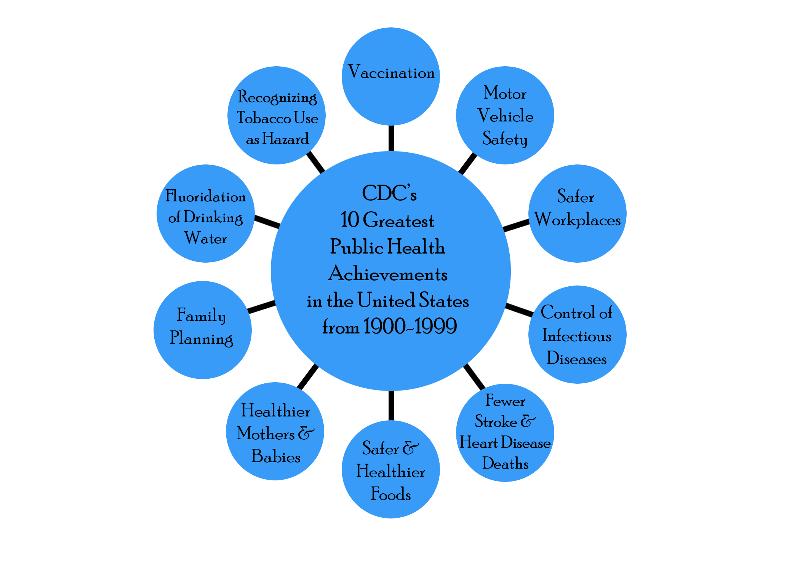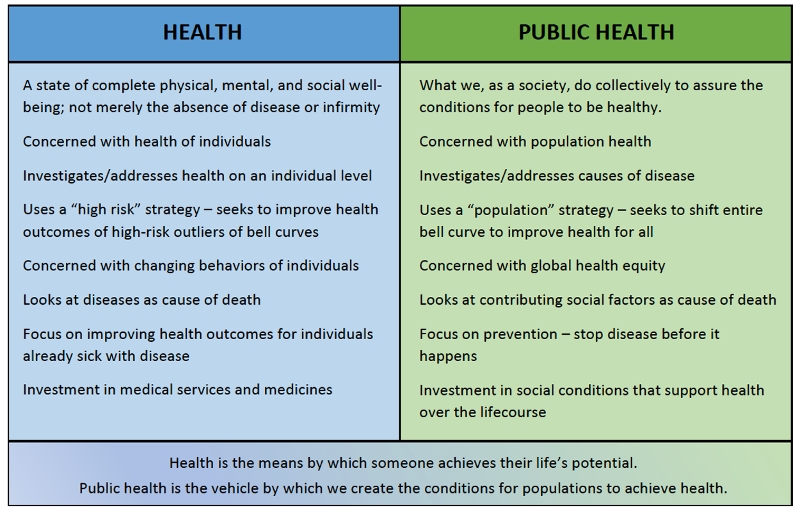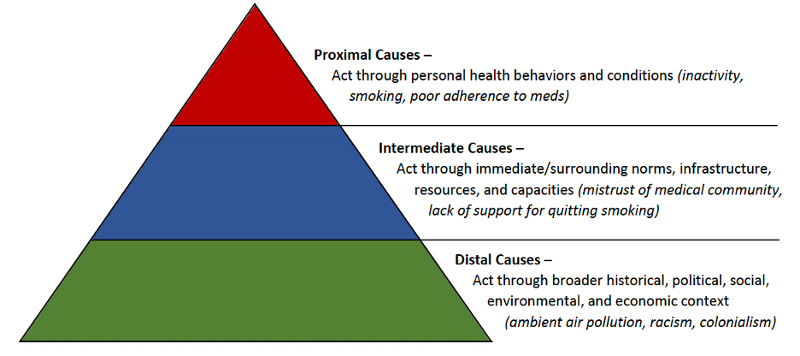
Mini-MPH
For Local Public Health Professionals
The world's health needs are changing - evolving day to day, sometimes even hour to hour. It is the role of public health to investigate pressing challenges and to develop meaningful interventions that improve conditions affecting population health. Local board of health officials in Massachusetts should have a foundational knowledge in public health in order to be more effective health and wellness leaders in their community.
After completing this course, you will be able to:
|
What is health? What is public health? The World Health Organization (WHO) defines health as: "...a state of complete physical, mental, and social well-being; not merely the absence of disease or infirmity." The Institute of Medicine (IOM) defines public health as: "...what we, as a society do collectively to assure the conditions for people to be healthy." As you learn about the role and goals of public health from the recordings in this training, think about how these definitions can assist and guide you in your work of being health and wellness leaders in your community. |
After completing this section, you will be able to:
For this video, and the subsequent ones in this training, select the arrow in the center of the screen or in the bottom right corner to play it. You can navigate forward/backward in the narration by using the menu, which can be accessed via the three horizontal bars in the top left corner of the screen. A transcript is available by selecting "Resources" in the top right corner of the screen.
Listen to the following recording (approximately 10 minutes).
|
Addressing Chronic Health Conditions in Your Community |
|
As discussed in the video, depression and obesity are pressing public health concerns.
Refer to the last page of this training to access these and other public health resources:
Remember, the core role of public health is to create a healthy world. Always be mindful of ways in which you can get more involved in combating important public health challenges in your community. |
Listen to this recording (approximately 15 minutes).
This image lists the CDC's 10 Greatest Public Health Achievements from the 20th Century. Think about what current and future public health efforts might make the list of greatest public health achievements over the next 100 years.

Listen to this recording (approximately 20 minutes).
|
Defining Health Equity |
|
How do you define health equity? How do you address health equity in your daily public health work? For some best practices and practice-based strategies to incorporate equity into foundational skills of public health and to advance health equity in your community, review the CDC publication A Practitioner's Guide for Advancing Health Equity: Community Strategies for Preventing Chronic Disease. According to the Guide, health equity means that every person has an opportunity to achieve optimal health regardless of:
|
Listen to this recording (approximately 12 minutes).
 Review your community's most recent annual report, especially the sections that the Board of Health adds and the budget section. If you're not sure where to find it, ask your Town or City Clerk.
Review your community's most recent annual report, especially the sections that the Board of Health adds and the budget section. If you're not sure where to find it, ask your Town or City Clerk.
Compare the annual budgets for town/city departments (i.e., school, fire, police, recreation/parks) to the annual budget for public health.
In your opinion, is your community prioritizing public health? If not, consider ways you might be able to educate community leaders and residents about the value of public health.
Listen to this recording (approximately 15 minutes).
|
Collaboration in Your Community |
|
Are there health issues or certain populations in your community that require collaboration in order to shift the prevalence vs. risk factor curve "to the left" as described in the recording? Using students as your population of interest, consider how you could collaborate with your school department.
Of course, there are many other potential collaborators who are concerned about youth. Getting to know your community will help you identify them. We need many partners to achieve our mission of creating healthier communities and a healthier world. |
|
How much of your daily public health work is informed by data? Do you know the difference between quantitative and qualitative data? Data provides evidence to support programs and policies that are designed to improve individual and population health. There are two kinds of data:
Both types of data are important to public health work. |
After completing this section, you will be able to:
Listen to this recording (approximately 22 minutes).
|
Data Sources |
|
What health data sources are available to you? What data points do you contribute to local or state data collection systems? Review the data resources listed on the last page of this training. Consider bookmarking them on your computer. |
Listen to this recording (approximately 12 minutes).
Listen to this recording (approximately 13 minutes).
|
Absolute vs. Relative Measures of Association |
|
We often want to compare estimates of prevalence or incidence between groups (e.g., those who follow a healthy diet versus those that follow an unhealthy diet). Remember, there are two types of comparisons:
Once we have these measures, we then need to determine if they suggest a difference in prevalence or incidence between groups, and there are statistical approaches to these assessments.
Which is best to use when determining risk for students in a school setting? It depends on the question you ask. Use absolute measures for questions like:
Use relative measures for questions like:
|
Listen to this recording (approximately 7 minutes).
Listen to this recording (approximately 11 minutes).
|
How often do you advocate for your public health agency and its programs? Are you familiar with the elements of effective advocacy and coalition building? Before moving on, read this policy brief on the power of advocacy released by the American Public Health Association. Advocacy extends beyond interacting with lawmakers. Some additional advocacy efforts include:
|
After completing this section, you will be able to:
Listen to this recording (approximately 16 minutes).
|
Effective Advocacy |
|
Think of a health policy you would like to change in your school, district, or community.
It is important to know the answer to both of these questions before you advocate for any change in health policy. |
Listen to this recording (approximately 15 minutes).
|
Coalitions |
|
Think back to a time you were part of a coalition. Consider the following questions:
|
Listen to this recording (approximately 9 minutes).
|
Do you know the difference between a law and policy? How have laws and policies impacted your daily work? Federal laws and policies, as well as state and local ones, will shape much of your work. Laws and policies, however, are not the same thing, so be sure you understand the difference. Periodically review any local board of health regulations in your community, and update your work as necessary. You should also be familiar with the municipal by-laws that impact public health - things like zoning restrictions, wetland protection measures, and building setbacks can all impact your public health programs. |
After completing this section, you will be able to:
Listen to this recording (approximately 23 minutes).
|
Manual of Laws and Regulations Relating to Boards of Health |
|
Print, save, or bookmark the Massachusetts Department of Public Health's Manual of Laws and Regulations Relating to Boards of Health. Review this manual to familiarize yourself with the large scope of responsibilities that local boards of health in Massachusetts have.
|
Listen to this recording (approximately 20 minutes).
Review this tabbed activity to learn more about the differences between laws and policies (adapted from DifferenceBetween.net).

Listen to this recording (approximately 20 minutes).
|
Health Care Access |
|
Take a moment to think about the consequences you see in your community as a result of changes in policies or laws related to health care access. Specifically, consider these questions:
|
|
How would you define health and public health? Re-read the definitions of health and public health that were provided at the beginning of this training: The World Health Organization (WHO) defines health as: "...a state of complete physical, mental, and social well-being; not merely the absence of disease or infirmity." The Institute of Medicine (IOM) defines public health as: "...what we, as a society do collectively to assure the conditions for people to be healthy." After having learned about the role and goals of public health from all of the recordings in this training, would you agree with these definitions? How you would change or build upon them? |
After completing this section, you will be able to:
Listen to this recording (approximately 5 minutes).
Review this image that illustrates the difference between health and public health. Be sure you are able to articulate the difference, since public health is often misunderstood.

Listen to this recording (approximately 12 minutes).
Complete this tabbed activity that summarizes the five steps of the public health approach to addressing problems.

Listen to this recording (approximately 7 minutes + 34 minutes for optional videos).
Review this image that defines proximal, intermediate, and distal factors that cause disease.

Listen to this recording (approximately 16 minutes).
|
Practice |
|
Using one of the two examples Professor Godley listed on the Let's Practice slide, answer these questions: 1. What is the actual health risk? 2. At which level(s) of the social ecological model do you feel interventions are needed? 3. What are your suggested interventions? 4. Which intervention do you think would have the best chance of success? Why?
|
|
Do you remember the difference between quantitative and qualitative data? Take a moment to review the difference between quantitative and qualitative data:
Both types of data provide evidence to support programs and policies that can improve individual and population health. |
After completing this section, you will be able to:
Complete the online course Data Collection for Program Evaluation (3 hrs), offered by the Northwest Center for Public Health Practice, to learn more about ways to collect the evidence you need to determine your public health program's impact. Note: This course requires an account and registration (free and quick) and provides its own continuing education credits and certificate of completion.
Congratulations! You have completed the Mini-MPH, and should now have a foundational knowledge of public health.
Print or save this Job Aid (PDF) that summarizes the key points.
You are now able to:
If you feel you need additional exposure to this material, you may repeat the training or return to any of the pages at any time.
If you would like further information about this topic, please consult the following websites and materials.
Data
Additional Trainings
Thank you for taking this training! We hope you will take another one soon.
If you planned to receive a certificate of completion, you should have completed the pre-test before starting this training. You won't be able to access the post-test if you haven't completed the pre-test.
Now, please complete the post-test and evaluation. You will be prompted to login again.
Once you complete the post-test and evaluation, you can click on 'View your continuing education certificate' and print or save it. A copy will also appear in your learner profile (accessed from the Login/Register page by selecting Status of Training Participation).